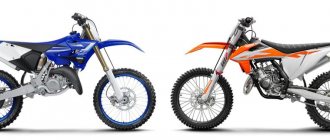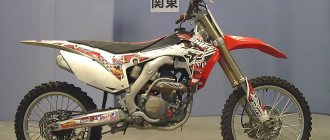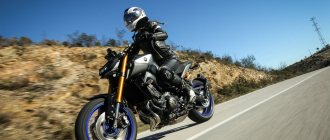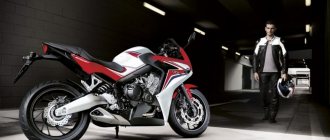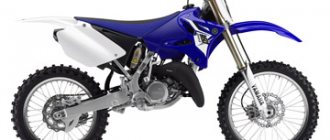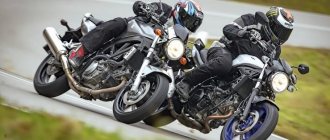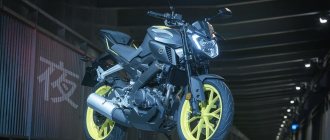| Yamaha NIKEN (2019+) | Yamaha NIKEN GT (2019+) |
Sports-touring model Yamaha NIKEN
was first presented in 2021 at the Tokyo Motor Show, and official sales started in September 2021 (model year 2019).
The model is distinguished by a unique concept, which is based on the use of two front wheels and the proprietary LMW (Leaning Multi Wheel) system, which allows a three-wheeled motorcycle to gain the controllability of a two-wheeled one. Before the advent of the NIKEN model, similar technologies were used in the Yamaha Tricity scooter.
The Yamaha NIKEN was based on the engine from the MT-09 series - an in-line 3-cylinder liquid-cooled unit with a volume of 847 cm³ and producing 115 hp. power and almost 88 Nm of torque.
The motorcycle frame is a structure made of steel pipes with aluminum elements, in particular the swingarm. The front suspension is a combination of two inverted telescopic forks on each wheel, fully adjustable. The LMW system achieves the effect of a fully independent front suspension, providing optimal traction in almost all conditions and in all weathers.
In parallel with the regular NIKEN version, the NIKEN GT is offered on the market. This modification is distinguished by high touring glass, a more comfortable saddle, heated hands, side panniers, a luggage rack, two 12V sockets and a central stand.
NIKEN series models are also equipped with all modern Yamaha electronic technologies:
- Electronic throttle (YCC-T - Yamaha Chip Controlled Throttle)
- ABS
- Cruise control
- Traction control system (TCS - Traction Control System)
- Selectable D-Mode
- Quick shifter (QSS - Quick Shift System)
- Assist and Slipper clutch
Specifications
Yamaha NIKEN Specifications:
| Model | Yamaha NIKEN |
| Motorcycle type | sports-tourist |
| Year of issue | 2019+ |
| Frame | Hybrid (steel pipes, aluminum swingarm) |
| engine's type | 3-cylinder, 4-stroke, in-line |
| Working volume | 847 cm³ |
| Bore/Stroke | 78.0 x 59.1 mm |
| Compression ratio | 11.5:1 |
| Cooling | liquid |
| Number of valves per cylinder | DOHC, 4 valves per cylinder |
| Fuel supply system | Injector with YCC-T (Yamaha Chip Controlled Throttle), 3x 41 mm |
| Ignition type | TCI |
| Maximum power | 115.0 hp (84.6 kW) at 10,000 rpm D-Mode TCS (Traction Control System) Cruise Control System |
| Maximum torque | 87.5 Nm (8.8 kg-m) at 8500 rpm |
| Clutch | Multi-disc in oil bath, cable drive |
| Transmission | 6-speed QSS (Quick Shift System) |
| type of drive | chain |
| Front tire size | 2x 120/70-R15 M/C (56V) |
| Rear tire size | 190/55-R17 M/C (75V) |
| Front brakes | 2 discs, 298 mm, 4-piston radial calipers (ABS) |
| Rear brakes | 1 disc, 282 mm, 2-piston caliper (ABS) |
| Front suspension | 2x 43/41 mm inverted fork (LMW system - Leaning Multi Wheel) (fully adjustable), travel - 110 mm |
| Rear suspension | Pendulum with monoshock absorber (fully adjustable), stroke - 125 mm |
| Motorcycle length | 2150 mm |
| Motorcycle width | 885 mm |
| Motorcycle height | 1250 mm – NIKEN 1425 mm – NIKEN GT |
| Wheelbase | 1510 mm |
| Seat height | 820 mm – NIKEN 835 mm – NIKEN GT |
| Minimum ground clearance (clearance) | 150 mm |
| Acceleration 0-100 km/h (0-60 mph) | 3.42 sec[1] |
| Maximum speed | 219 km/h[2] |
| Gas tank capacity | 18.0 l (including reserve - 4.0 l) |
| Motorcycle weight (curb) | 263.0 kg – NIKEN 267.0 kg – NIKEN GT |
Yamaha Niken
When the standard Yamaha Niken was introduced to the world's motorcycle publications in the Austrian Alps in the spring of 2021, everyone was surprised at how comfortable it was in lean turns on poor road surfaces.
Of course, after discussing the pros of the Yamaha Niken, there was talk about the cons: the large mass of the front suspension (levers, two steering columns, four forks, an additional wheel - a total of about 45 extra kilos) and a maximum tilt angle of 45 degrees (due to the fact that the front the suspension is not able to fold further to accommodate a greater tilt) characterize the Niken rather as a utilitarian, but not a sports motorcycle, despite its base being common with the Yamaha MT-09. However, add a couple of touring accessories, such as a softer Comfort Series seat with improved padding on both the driver and passenger sides, a taller windshield, heated grips, quick-release saddlebags, passenger handles with center saddlebag mounts, a center stand and an additional 12-volt power outlet. , you can get a very decent sports-touring motorcycle called the Yamaha Niken GT, which does not cause disappointment at all when comparing its characteristics with other representatives of this category.
Results
Should I buy it for myself? It's clear that to ride faster you need to buy faster bikes, and the added weight and complexity of the design can create problems. But if I lived in an area where the weather is often bad, I would definitely consider buying a Yamaha Niken GT.
Kudos to Yamaha for pushing the boundaries of motorcycle transportation, and while we don't know if this design will continue to evolve, we can be sure that bikes like the Niken are influencing the way we think about motorcycle comfort and safety.
Such designs are the end for two-wheelers
You don't have to be Sherlock to notice that Niken isn't on two wheels. It would seem that the development of such designs would kill the motorcycles that we have known for more than a hundred years. However, I got the impression, bordering on certainty, that this was simply an attempt to attract those who had not thought about a motorcycle at all.
Secondly, it is for those who are afraid to switch to a “large” cubic capacity due to fear of their skills. The third group are fans of crazy designs. Just add a compressor to the Niken, and many will surely love it for its drifting properties!
Myth busted: two-wheeled bikes will last forever. Niken should open up a new path for Yamaha, not kill something that has been in development for years.
Get the most out of your Yamaha Niken GT
The next day the roads were dry and I tried to get the most out of the Yamaha Niken GT to see if its unusual front suspension had any limitations. For most situations, the answer is a clear “No.” Of course, in the right hands, it’s very easy to force the Yamaha Niken GT to hit the kickstand, but it’s simply not worth forgetting that you’re riding a 260-kilogram motorcycle and pushing it harder. At the same time, keep in mind that not many sports tourists will easily overtake Niken.
Yamaha Niken GT engine
And now it's time to talk about the 893 cc three-cylinder engine, which is essentially the same as in the MT-09/Tracer 900 GT, with an 18 percent increased crankshaft weight for improved handling, a shorter final gear thanks to an additional two teeth on the rear sprocket , and stronger transmission material to support the increased weight. A larger engine is not needed here: the Yamaha Niken GT accelerates at an almost incredible speed for a 900 cc engine, while the throttle response is smooth and comfortable. The standard quickshifter works great even at low revs (though it doesn't engage below 4000 to prevent unnecessary strain on the gearbox), and the same Y-CCT system found on its MT-09/Tracer 900GT siblings provides three modes of engine response and two modes of traction control (plus it can be turned off completely), as well as cruise control.
Accessories
The tall windshield provides good wind protection for someone of my height (I'm 170cm), and an optional windshield is available for taller riders. The seat passed the 200-mile test with flying colors, and the heated grips are hard to beat in cool weather. Quick-release saddlebags provide good luggage capacity.
Yamaha Niken GT 2019
I didn’t go, but in my opinion it’s not comfortable!
People of non-standard height, disabled people, people with a sore spine or after accidents. A large group of potential users that until now “did not exist” for motorcycle companies...
I understand your distrust of the new. There was a similar attitude after the presentation of the iPhone by the then head of Microsoft. Today we know how many phones both companies sell.
I recommend to all Niken haters to ride in the rain in the mountain corners. If they ride their two wheel bikes with the same speed, lean and confidence, I will be the first to sign a petition to kill everything with three wheels.
Amen!
The myth is waiting to be refuted: short and to the point - if you haven’t tried it, don’t say so! Perhaps this motorcycle will not be accepted into the market - we will find out in a few years. On the other hand, talking about its uselessness without a test drive is like talking about expeditions into space after visiting a village museum.
Post Views: 794
Yamaha Tricity 125 review
We present to your attention the world's first serial three-wheeled scooter from Yamaha. The new product received the official name “Tricity 125”. The manufacturer's plans for the model are very ambitious - in the first year, the Japanese are determined to sell at least ten thousand copies worldwide. The task looks quite feasible, considering that the Tricity 125 has practically no competitors on the European market (of course, there is the MP3 125 Yourban three-wheeler from the Italian concern Piaggio Group, however, judging by the Yamaha release, the new Tricity 125 will be almost one and a half times cheaper And this is with similar technical characteristics and capabilities of scooters!). From now on, Yamaha scooters cover all popular classes of urban scooters today!
The main feature of the scooter is, of course, its three-wheeled chassis. The third wheel gives very high stability and stability on the road, better control over the equipment. Now novice drivers and those who are afraid of two-wheeled vehicles will be able to reconsider their attitude towards city scooters.
The main advantages of the new three-wheeled scooter Yamaha Tricity 125:
- — stylish and modern design with a focus on “Sports”;
- — the three-wheel configuration guarantees excellent stability of the scooter at any speed;
- — the front wheels are located as close as possible to each other for better maneuverability;
- — exclusive design of rims;
- — advanced suspension system — “Leaning Multi Wheel” (LMW);
- — LED head optics;
- — digital instrument panel;
- — a lightweight, compact and easy-to-use scooter for every day;
- — large luggage compartment – one of the best in its class;
- — natural driver position when operating a scooter;
- — comfortable double seat;
- — economical and high-speed engine with a volume of 125 “cubes” with liquid cooling;
- - front and rear brakes - disc;
- — unified brake system “Unified Brake System” (UBS);
- — four spectacular colors of the scooter in an affordable range.
The new product has a stylish design with a sporty accent. The front of the scooter has a nice design with smooth lines and excellent protection for the rider's legs. The presence of an additional wheel at the front visually gives the scooter a special charm, a feeling of confidence and stability.
A comfortable driving position with a spacious two-level seat makes any trip comfortable. The passenger's seat is slightly higher than the driver's, and the smooth transition forms a kind of comfortable backrest for the driver. Under the seat there is a spacious luggage compartment that can accommodate one helmet and additional hand luggage.
Folding footrests and side handles are provided for the passenger. The Yamaha Tricity frame is designed for maximum rider comfort - there is plenty of free space for his legs on the flat bottom area.
The optics of the three-wheeled scooter are completely LED. The instrument panel is digital; all kinds of readable information can be displayed on its display. The variety of digital sensors and modules on a scooter is no worse than in a car.
Main available colors of the 2014 Yamaha Tricity 125 scooter:
- Anodized Red colorway;
- gray color “Mistral Grey”;
- white color “Competition White”;
- black color "Midnight Black".
In space, the three-wheeled Yamaha scooter measures 1905 mm in length, 735 mm in width and 1215 mm in height. The low seat height of 780 mm guarantees the versatility of this model - Tricity 125 is successfully suitable for any age, any gender and driving experience!
The front suspension is a completely traditional telescopic fork. Japanese designers combined the two wheels with the so-called Leaning Multi Wheel (LMW) parallelogram system, which provides independent wheel suspension. Rear suspension - Unit Swing system.
Following the tradition of other models, the Yamaha Tricity 125 uses wheels of different diameters at the front and rear. There are 14-inch alloy wheels at the front and 12-inch wheels at the rear. The tire sizes are 90/80-14 and 110/90-12, respectively.
The Yamaha Tricity 125 scooter is currently offered in only one modification with one single engine. This is a single-cylinder, four-stroke, liquid-cooled unit with two SOHC valves. Its working volume is 124.8 cubic meters. cm. The engine develops a power output of 11 hp. at 9000 rpm and peak torque of about 10.4 Nm (achieved at 5500 rpm). The engine is equipped with an automatic transmission “V-Belt Automatic”.
The not very impressive power and torque of the engine is undermined by the very light weight of the scooter. The curb weight of the new product does not exceed 152 kg with a fully filled tank! In addition, Japanese engineers managed to achieve ideal weight distribution between the axles - 50 to 50.
The engine is equipped with an electronic fuel supply system, which has a positive effect on its appetite. With an average fuel consumption of 3 liters per 100 km, a 6.6-liter tank should be enough for a distance of 200 km. The indicator is quite good for the city, but with out-of-town trips you will have to constantly calculate the remaining fuel.
While there may still be some questions about the low performance of the Yamaha Tricity 125, its safety is absolutely fine. Each of the three wheels is equipped with a hydraulic disc brake. The front wheels were equipped with discs with a diameter of 220 mm, the rear wheel was equipped with a brake disc with a diameter of 230 mm.
Another advantage of the Yamaha scooter is the presence of a single brake system “Unified Brake System” with which the Tricity 125 can be effectively stopped in any situation and on any road surface. UBS is organized according to this principle - when you press the left steering brake, all three brake discs are activated, and when you use the right lever, only the mechanisms on the front wheels are activated.
Technical characteristics of three-wheeled scooter: Yamaha Tricity 125
ENGINE Yamaha Tricity 125 2014
: Engine type: single-cylinder, four-stroke, liquid-cooled, 2-valve, SOHC; Working volume: 124.8 cubic centimeters; Bore and stroke: 52.4 mm and 57.9 mm; Compression ratio: 10.9:1; Maximum power: 8.1 kW (11.01 hp) at 9000 rpm; Maximum torque: 10.4 Nm at 5500 rpm; Lubrication system: wet sump system; Fuel system: fuel injection system (Fuel Injection); Ignition system: transistorized battery ignition (TCI); Starting system: electric starter; Transmission: V-Belt Automatic.
CHASSIS Yamaha Tricity 125 2014: Front suspension system: telescopic fork; Rear suspension system: Unit Swing system; Front brake: double discs with a diameter of 200 mm; Rear brake: hydraulic, single disc with a diameter of 230 mm; Front wheels (tires): 90/80-14; Rear wheel (tires): 110/90-12.
DIMENSIONS Yamaha D'elight 2014
: Overall overall length: 1905 mm; Overall overall width: 735 mm; Overall overall height: 1215 mm; Seat height: 780 mm; Wheelbase: 1310 mm; Minimum ground clearance: 120 mm; Weight when filled: 152 kg; Fuel tank capacity: 6.6 liters.
Is a motorcycle as wide as a car? Is not cool!
The gadget is great, but... The motorcycle stuck in a traffic jam appeared ten years ago. His name was Kan Am Spider.
If approved, you do not need to take a test drive. All you need are the size charts available on the manufacturer's website. The Yamaha Niken has an overall width of 885mm. A few examples for comparison:
- Can-Am Spyder 1506 mm
- BMW R1200GS 952.5 mm
- Honda Africa Twin AS 930 mm
- Honda Gold Wing 925 mm
- Suzuki V-Strom 650XT 910 mm
- BMW R nine T. 900 mm
- Yamaha SCR950 895 mm
- Yamaha Niken 885 mm
- Yamaha Tracer900 850 mm
- Yamaha MT-09 815 mm
- Suzuki SV650XA 760 mm
It is clear that in terms of overall width, Niken is quite far from Kan-Am. Of course it will never be a typical city bike, but when I look at the number of GS, I get the impression that hardly anyone cares.
Myth busted: there are plenty of wider bikes out there. The Niken, despite having two wheels at the front, maneuvers much better than several other hits from the motorcycle market.
Yamaha Niken GT
Mountain roads are the best way to appreciate the benefits of the unique Yamaha Niken front suspension. Driving along winding serpentines is damn fun, but the condition of the road surface on them always leaves much to be desired: gravel, broken asphalt, potholes, mud, puddles and other joys of mountain roads are quite dangerous, especially when driving at high speed and in turns. Mother Nature prepared another surprise for our team - quite heavy rain, which allowed us to fully appreciate the capabilities of the Yamaha Niken GT.
Yamaha Niken GT 2019
Obviously, the traction of the front tire (or tires) is critical to the control of the motorcycle. If you lose grip in the rear, you can regain control of the situation with traction control or good riding skills. But losing the grip of the front tire (unless you are Marc Marquez) is a surefire way to fall off. Especially on wet surfaces, where there is only one moment between riding and sliding.
Yamaha Niken GT on wet asphalt
And in such conditions, the Yamaha Niken GT performs just fine. On wet, slippery pavement where I'd be forced to sneak around corners at a snail's pace, the Niken GT gave me such confidence and grip that I leaned it like never before. No, I'm not saying that its two front wheels are a guarantee of safety under any road conditions and any actions of the rider, but they make the motorcycle stable enough to feel confident and enjoy the ride instead of fear. And this confidence does not come out of nowhere: it’s all about the safety that the additional contact patch provides. And even when I went a little over the line and tore off the front end, this stall was quite weak and controlled, that is, I felt it, but remained in control and calm, not at all like it would have been with one front wheel.
Broken asphalt and small debris on the road are another danger that the Yamaha Niken GT copes with effortlessly. Due to the fact that the suspension of each wheel works independently of the second, when one wheel handles a bump, the second maintains traction and trajectory, so you simply don’t feel most bumps, even when turning.
By the way, about turns: the Yamaha Niken GT handles with the eagerness of, if not a sports, then a good sports-touring motorcycle, and it performs trail breaking in turns with ease, and its brakes are powerful and predictable.
Yamaha Niken GT 2019


